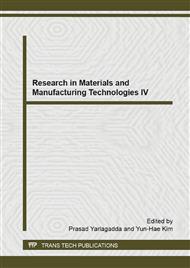p.162
p.166
p.170
p.175
p.180
p.184
p.189
p.193
p.201
The Transformation of ZnO Nanostructures Prepared by Thermal Evaporation
Abstract:
ZnO nanostructures prepared by thermal evaporation method using Zn metal plate in water vapor were invitigated. The Zn metal plates were ultrasinically cleaned at room temperature and then heated in a furnace at temperatures ranging from 350 to 430 °C for 2 hours. The ZnO nanostructures were characterized by X-ray diffraction (XRD) and scanning electron microscopy (SEM). XRD patterns show the ZnO hexagonal wurtzite structure. SEM images indicate that the ZnO structures depend on preparation temperatures. The density of ZnO nanostructures increase as the temperature increases. The transformation of ZnO nanostructures was observed to be temperature dependence. The nanostructures are nanorods when prepared at temperature below 400 °C, nanowires when prepared at 400 °C, and nanoflakes when prepared temperatures of 410 °C or higher. This approach provides the capability of creating patterned 1D ZnO nanowires at 430 °C. The diameter of ZnO nanowires werevaried from 20 nm to 70 nm and length of several 400 micrometers.
Info:
Periodical:
Pages:
180-183
Citation:
Online since:
December 2014
Authors:
Keywords:
Price:
Сopyright:
© 2015 Trans Tech Publications Ltd. All Rights Reserved
Share:
Citation:


